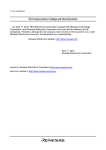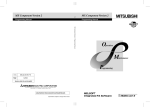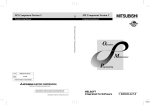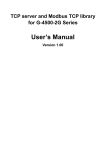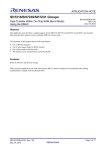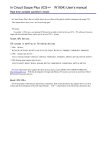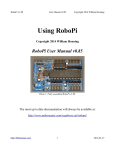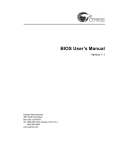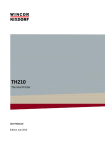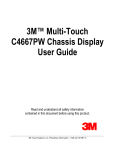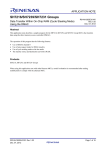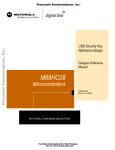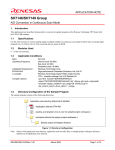Download SH7216 Group USB Function Module
Transcript
APPLICATION NOTE SH7216 Group R01AN2201EJ0100 Rev. 1.00 August 20, 2014 USB Function Module: USB Communication Class Application Note Introduction This document explains how to implement the system applied to the USB communication class as an application example for the SH7216 Group’s USB function module. This document and the sample program described are examples of the USB function module, and are therefore not guaranteed by Renesas. Target Device This example supports the following device. - SH7216 Group R01AN2201EJ0100 Rev. 1.00 August 20, 2014 Page 1 of 26 SH7216 Group USB Communication Class Application Note Contents 1. Overview ............................................................................................................................................. 3 1.1 Functions Used ............................................................................................................................ 3 1.2 Applicable Conditions .................................................................................................................. 3 1.3 Related documents ...................................................................................................................... 3 2. Applications ........................................................................................................................................ 4 2.1 Features ....................................................................................................................................... 4 2.2 USB Communication via the USB Function Module .................................................................... 5 2.3 Detecting a Connection to the USB Host..................................................................................... 6 2.4 Control Transfer ........................................................................................................................... 7 2.5 Bulk Transfer .............................................................................................................................. 16 3. System Example of the USB Communication Class ........................................................................ 20 3.1 Overview .................................................................................................................................... 20 3.2 Operation Flow ........................................................................................................................... 21 3.3 Serial Communication ................................................................................................................ 22 3.4 Environment Setting................................................................................................................... 25 4. Reference Documents ...................................................................................................................... 26 R01AN2201EJ0100 Rev. 1.00 August 20, 2014 Page 2 of 26 SH7216 Group USB Communication Class Application Note 1. Overview This document explains how to use the SH7216 USB function module, and how to implement the system applied to the USB communication class as an application example for the USB function module. 1.1 Functions Used Interrupt controller (INTC) Pin function controller (PFC) USB function module (USB) Serial communication interface (SCI) 1.2 Applicable Conditions MCU SH7216 Operating frequency Internal clock: 200 MHz Bus clock: 50 MHz Peripheral clock: 50 MHz MTU2S clock: 100 MHz AD clock: 50 MHz Integrated development environment Renesas Electronics High-performance Embedded Workshop, Ver. 4.07.00 C compiler Renesas Electronics SuperH RISC engine Family C/C++ Compiler Package, Ver. 9.03.00, Release 02 Compile options High-performance Embedded Workshop default settings (-cpu=sh2afpu -fpu=single - include="$(WORKSPDIR)\inc","$(WORKSPDIR)\src\inc" -object="$(CONFIGDIR)\$(FILELEAF).obj" -debug -gbr=auto -fpscr=safe -chgincpath -errorpath -global_volatile=0 -opt_range=all -infinite_loop=0 -del_vacant_loop=0 -struct_alloc=1 –nologo) 1.3 Related documents The following application note is related to this application note. Refer to it as necessary in conjunction with this application note. SH7216 Group USB Function Module: USB Mass Storage Class Application Note (REJ06B0897) SH7216 Group USB Function Module: USB HID Class Application Note (REJ06B0898) SH7216 Group Protocol Conversion between Ethernet and USB Application Note (R01AN0066EJ) SH7216 Group USB Multifunction Operation of USB Function Module Application Note (R01AN0294EJ) SH7216 Group Using USB to Reprogram Flash Memory in User Program Mode Application Note (R01AN0316EJ) SH7216 Group Peripheral LibUSB Demo Application Note (R01AN0889EJ) R01AN2201EJ0100 Rev. 1.00 August 20, 2014 Page 3 of 26 SH7216 Group USB Communication Class Application Note 2. Applications This sample program uses the USB function module to execute the control IN, control OUT, bulk IN, and bulk OUT transfers. The sample program also converts USB to serial signals and vice versa based on the USB communication class. 2.1 Features The USB function module has an embedded USB 1.1 compliant USB Device Controller (UDC) and operates the USB protocols automatically. Figure 2.1 is a block diagram of the USB function module. On-chip peripheral bus [Interrupt request signal] USI0, USI1 [DMA/DTC transfer request signal] USBRXI0, USBTXI0 USBRXI1, USBTXI1 USB function module Status and control registers Protocol processor USD+ Transceiver USD- FIFO USB clock (48 MHz) Figure 2.1 Block Diagram of USB The features of the on-chip USB function module of the SH7216 are as follows. Automatic processing of USB protocol Automatic processing of USB standard commands for endpoint 0 (Some commands need to be processed through the software.) Transfer speed: Full speed Interrupt requests: Generation of interrupt signals needed for USB transmission and reception Clock: External input clock generated by USB oscillator (48 MHz) Low-power mode Integrated bus transceiver Endpoint configurations: There are ten mounted endpoints for each transfer mode, and transfers data in the control transfer, bulk OUT transfer, bulk IN transfer, and interrupt transfer to the USB host. Table 2.1 shows those configurations. R01AN2201EJ0100 Rev. 1.00 August 20, 2014 Page 4 of 26 SH7216 Group USB Communication Class Application Note Table 2.1 Endpoint Configurations Endpoint Endpoint 0 Endpoint 1 Endpoint 2 Endpoint 3 Endpoint 4 Endpoint 5 Endpoint 6 Endpoint 7 Endpoint 8 Endpoint 9 2.2 Name EP0s EP0i EP0o EP1 EP2 EP3 EP4 EP5 EP6 EP7 EP8 EP9 Transfer Type Setup Control-in Control-out Bulk-in Bulk-out Interrupt-in Bulk-in Bulk-out Interrupt-in Bulk-in Bulk-out Interrupt-in Max. Packet Size 8 bytes 16 bytes 16 bytes 64 bytes 64 bytes 16 bytes 64 bytes 64 bytes 16 bytes 64 bytes 64 bytes 16 bytes FIFO Buffer Capacity 8 bytes 16 bytes 16 bytes 64 2 (128) bytes 64 2 (128) bytes 16 bytes 64 2 (128) bytes 64 2 (128) bytes 16 bytes 64 bytes 64 bytes 16 bytes DMA Transfer Possible Possible Possible Possible USB Communication via the USB Function Module As an example of using the USB function module for USB communication, the sample program implements the USB communication features listed in the table below. Table 2.2 USB Communication Functions USB Communication Features Description Detect a connection to the USB host The port pulls up the D+ pin to detect a connection. Decodes requests, processes the Data stage and Status stage of the Control transfer USB request transmitted from the USB host in the control transfer. Bulk IN/OUT transfers Executes bulk IN/OUT transfers. R01AN2201EJ0100 Rev. 1.00 August 20, 2014 Page 5 of 26 SH7216 Group 2.3 USB Communication Class Application Note Detecting a Connection to the USB Host A connection to the USB host is detected using the cable connect interrupt (the BRST bit in the USBIFR0 register). The cable connect interrupt occurs when a USB device cable is connected to the USB host. After the user configures the MCU, the sample program pulls up the USB data bus D+ pin using the general output port. The USB host recognizes that a USB device is connected by the pull-up. Figure 2.2 shows an operation flow of the sample program. USB Function (Hardware) Sample Program (Software) Reset Start Set CPG Set Power-Down Mode Cable is not connected VBUS = 0 UDC core is reset Configures the MCU Set PFC Set INTC USB and SCI1 USB cable is connected SciInit Initializes the SCI module Set SCI clock source Set_SMR Set SCI communication parameter UsbInit No Initializes the USB operation Pulls up D+ pin Yes Clears the interrupt mask level InitBulkMem Initializes work area Connects a cable UsbStart Pull-up enabled D+ pin (PB15) to High Releases the UDC core reset Main loop Detectes bus reset USBIFR0/BRSY = 1 Bus reset interrupt Set SCI interrupt USBIFR0/BRST interrupt SetUsbModule - Set USB to active - Configures End Point Set USBEPIR register - Configures the interrupt Set USBIER0 to USBIER2 and USBISR0 to USBISR4 registers Operation start ActBusReset Waits for receiving the setup command Clears SW flags and buffers Clears the bus reset flag USBIFR0/BRST = 0 Clears all EP FIFOs Operation end Figure 2.2 Detecting a Connection to the USB Host R01AN2201EJ0100 Rev. 1.00 August 20, 2014 Page 6 of 26 SH7216 Group 2.4 USB Communication Class Application Note Control Transfer A control transfer is a USB transfer that uses the endpoint 0 as the default pipe and must be supported by all USB devices. The USB host issues a USB standard request to the USB device and configures the device. A control transfer can be used to issue a class- or vendor-specific request command. A control transfer is composed of a Setup stage, Data stage (not in all cases), and Status stage. The Data stage consists of multiple bus transactions. Control transfers are supported via bi-directional communication flow, according to the data direction of the Data stage. A control OUT transfer is the data flow from the USB host to the USB device during the Data stage. A control IN transfer is the data flow from the USB device to the USB host during the Data stage. The Data stage is completed when the USB host transmits a token whose data direction is inverted to the previous data stages. The Status stage is the stage that transmits the inverted token to the USB host. Figure 2.3 shows the Data direction in the Data stage and Figure 2.4 shows each the control transfer stage configuration. Control OUT transfer USB host USB device Data Control IN transfer USB host USB device Data Figure 2.3 Data Direction in the Data Stage Control IN transfer Stages Setup stage SETUP Data stage IN IN Status stage … IN OUT Data direction inverted Control OUT transfer Stages SETUP OUT … OUT IN Multiple transactions Control transfer without data Stages OUT SETUP IN Figure 2.4 Control Transfer Stage Configuration R01AN2201EJ0100 Rev. 1.00 August 20, 2014 Page 7 of 26 SH7216 Group USB Communication Class Application Note The USB function module decodes the request, and automatically processes the Data stage and Status stage according to the USB standard request. Some of the USB standard requests, class requests, and vendor requests should be executed by the software. The sample program executes the Get Descriptor command, which is the USB standard request to be processed by the software and the conversion between USB and serial communication as the typical example of the USB communication class. To convert USB communication into serial communication, the sample program executes USB communication class requests. Table 2.3 lists USB commands and processing in the sample program. When the sample program receives a USB command that it does not support, it returns a STALL handshake. Table 2.3 USB Commands and Processing in the Sample Program USB Command Clear Feature Get Configuration Get Interface Get Status Set Address Set Configuration Set Feature Set Interface Get Descriptor Set Line Coding Set Control Line State Send Break Get Line Coding Other USB commands Type USB standard request Processing in the Sample Program The hardware decodes the command, and executes the Data stage and the Status stage automatically. The software does no operation. USB The software decodes the command, and executes the Data communication stage and the Status stage. class request The software returns a STALL handshake. R01AN2201EJ0100 Rev. 1.00 August 20, 2014 Page 8 of 26 SH7216 Group 2.4.1 USB Communication Class Application Note Setup Stage The Setup stage is composed of one setup transaction. The USB host sends a setup token or data packet (USB command), then returns a handshake in response to the data packet (USB command) that the USB device received. Figure 2.5 shows the setup transaction sequence. The USB function module automatically executes the Setup stage, Data stage, and Status stage in response to the USB requests (with some exceptions). If the received request is not a USB standard request, the USB function module holds the received request in the EP0s data register (USBEPDR0s), and generates the setup request receive complete interrupt using the SETUPTS bit in the USBIFR1 register. The sample program reads the USB request held in the data register (USBEPDR0s) during the interrupt, and decodes the USB request to determine how to process subsequent stages. If the decoded USB request is a request to execute the control IN transfer, the sample program writes the first data to transfer to the USB host in the EP0i FIFO and the interrupt is completed. Figure 2.6 shows an operation flow of the sample program. The function (DecComCommand) processes USB communication class requests in the sample program. Figure 2.5 Setup Transaction Sequence R01AN2201EJ0100 Rev. 1.00 August 20, 2014 Page 9 of 26 SH7216 Group USB Communication Class Application Note Sample Program(Software) (USBIFR1 interrupt) USB Function (Hardware) Executes the ActControl function in the USBIFR1 interrupt handler. Receives the EP0 setup token Operation Start Call ActControl Receives a command in EP0s Hardware processes each subsequently stage automatically. Yes Completed Therafter, ActControl internal operation Clears the setup request Receive complete flag SETUPTS = 0 Processed by hardware automatically? No USBIFR1/SETUPTS interrupt Sets the setup request receive complete flag GetPacket Acquires a USB command Completed Set the EP0S read complete flag EP0sRDFN = 1 DecStandardCommand Yes Operates the following commands. Set Line Coding, Set Control Line State, Send Break Get line Coding Class command? No DecComCommands No Operates only GetDescriptor command Supported class command? Yes Set STALL state Judged by bit 6 and 5 in bmRequest Class command is bit[6:5] = 01 No Supported standard command? Yes Set STALL state EpInfo[0].PresentState = STALL Prepares GetDescriptor data Yes STALL state? Is EpInfo[0].PresentState STALL? No Judged by bit7 in bmRequest Transfer direction? OUT (Host to device) IN (Device to host) Disables interrupt Set TRANS_OUT state Set TRANS_IN state Set STALL USBEPSTL/EP0STL = 1 Set the interrupt enable bit for control OUT transfer EP0iTSE = EP0oTSE = EP0iTRE = 1 Set the interrupt enable bit for control IN transfer EP0iTSE = EP0oTSE = 1 PutPacket Writes data to FIFO Operation end Figure 2.6 Setup Stage Operation Flow R01AN2201EJ0100 Rev. 1.00 August 20, 2014 Page 10 of 26 SH7216 Group 2.4.2 USB Communication Class Application Note Data Stage The Data stage of the control IN transfer is composed of single or multiple data transactions. The Data stage of the control IN transfer is composed of one data IN transaction. This is called “Data IN stage processing”. The Data stage of the control OUT transfer is composed of one data OUT transaction. This is called “Data OUT stage processing”. (1) Data IN Stage First, the USB host sends an IN token. When the USB device receives the IN token, it sends a data packet to the USB host and waits for an ACK handshake from the USB host. If the USB device cannot send a data packet when it receives the IN token, it returns a NAK handshake to the USB host. Figure 2.7 shows the data IN transaction sequence. When the USB function module receives an IN token without valid data in the EP0iFIFO, it automatically returns a NAK handshake to the USB host. When the module receives an IN token with valid data in the EP0iFIFO, it sends the data in the EP0iFIFO to the USB host and waits for an ACK handshake from the USB host. When the USB function module receives an ACK handshake, it generates the data transmit complete interrupt using the EP0iTS bit in the USBIFR0 register. On the contrary, when the module receives an OUT token that indicates the Data IN stage has been completed, it generates the data receive complete interrupt using the EP0oTS bit in the USBIFR0 register. The sample program identifies the type of the interrupt while it is being processed. When it is the data receive complete interrupt (the EP0oTS bit in the USBIFR0 register), the sample program advances to the Status stage. When it is the data transmit complete interrupt (the EP0iTS bit in the USBIFR0 register), data that should be sent to the USB host was written in the EP0iFIFO, and the sample program waits for the next interrupt. Figure 2.8 shows an operation flow of the Data IN stage by the sample program. Figure 2.7 Data IN Transaction Sequence R01AN2201EJ0100 Rev. 1.00 August 20, 2014 Page 11 of 26 SH7216 Group USB Communication Class Application Note USB Function (Hardware) Sample Program(Software) (USBIFR1 interrupt) Executes the ActControlIn function in the USBIFR1 interrupt handler. Receives the EP0 IN Token Set EP0sRDFN bit Operation start No Reading EP0sFIFO completed? Call ActControlIn via ActControlInOut ActControlIn Yes Set EP0iPKTE bit No Data receive complete interrupt? (USBIFR1/EP0oTS) Valid data in the EP0iFIFO? Yes Yes No Sends data to the host Clears USBIFR1/EP0iTS interrupt flag Executes the Status stage of the control IN transfer PutPacket NAK Returns NAK to the host When data direction changes, the Data stage is completed and advance to the Status stage. Waits for ACK Set EP0i transmit flag (USBIFR1/EP0iTS=1) Writes data to USBEP0i data register USBIFR1/EP0iTS interrupt USBTRG0/EP0iPKTE=1 When set EP0iPKTE to 1, data in the EP0iFIFO is validated. Completed Operation end Figure 2.8 Data IN Stage Operation Flow (2) Data OUT Stage The USB host sends an OUT token and a data packet. The USB device receives the OUT token first, then receives the data packet, and then returns an ACK handshake. When the USB device cannot receive the data packet after it receives the OUT token, it ignores subsequent data packets, and returns a NAK handshake. When the USB host receives the NAK handshake, it tries to resend the OUT token and data packet. Figure 2.9 shows the Data OUT transaction sequence. When the USB function module cannot receive data packets, when it receives the OUT token, it automatically discards the subsequent data packet and returns a NAK handshake to the USB host. When it receives the OUT token, when it can accept data, it holds the data packet from the USB host in the EP0oFIFO and returns an ACK handshake to the USB host. After the USB function module transmits an ACK handshake, it generates the data receive complete interrupt using the EP0oTS bit in the USBIFR1 register. When the function module receives the IN token that indicates the Data OUT stage is completed, it generates the IN token receive interrupt using the EP0iTR bit in the USBIFR1 register. The sample program identifies the type of the interrupt while it is being processed. When it is not the data receive complete interrupt (the EP0oTS bit in the USBIFR1 register), the sample program advances to the Status stage. When it is the data receive complete interrupt (the EP0oTS bit in the USBIFR1 register), the sample program reads data in the EP0oFIFO, sets the EP0oFIFO read complete bit, and waits for the next interrupt to be generated. Figure 2.10 shows an operation flow of Data OUT stage by the sample program. R01AN2201EJ0100 Rev. 1.00 August 20, 2014 Page 12 of 26 SH7216 Group USB Communication Class Application Note Idle Token OUT DATA0/1 Data ACK NAK STALL Handshake Packet issued by the host Idle Packet issued by the device Figure 2.9 Data OUT Transaction Sequence Figure 2.10 Data OUT Stage Operation Flow R01AN2201EJ0100 Rev. 1.00 August 20, 2014 Page 13 of 26 SH7216 Group 2.4.3 USB Communication Class Application Note Status Stage The direction of the data transaction in the Status stage differs from that of the Data stage; the data OUT transaction is executed during the Status stage of the control IN transfer, and the data OUT transaction is executed during the Status stage of the control OUT transfer. (1) Status Stage of the Control IN Transfer The USB host sends an OUT token and a 0-byte data packet. The USB device first receives the OUT token and then receives the 0-byte data packet. Then, it returns an ACK handshake to the USB host. The USB function module receives the OUT token and the 0-byte data packet, and automatically sends an ACK handshake to the USB host. Then, the USB function module generates the data receive complete interrupt using the EP0oTS bit in the USBIFR1 register. The sample program set the EP0oFIFO read complete bit (USBTRG0/EP0oRDFN) during an interrupt to wait for the next interrupt. Figure 2.11 shows an operation flow of the Status stage (control IN transfer) by the sample program. USB Function (Hardware) Receives the EP0 OUT token Sample Program(Software) (USBIFR1 interrupt) Executes the ActControlIn function in the USBIFR1 interrupt handler. Call ActControlIn via ActControlInOut Operation start Receives a 0 length data from the host ActControlIn ACK Clears EP0 related interrupt flag other than SETUPTS flag Returns ACK to the host Set the EP0o receive complete flag (USBIFR1/EP0oTS=1) USBIFR1/EP0oTS interrupt Changes the state to WAIT Writes 1 in the EP0o read complete bit (USBTRG0/EP0oRDFN=1) Completed Operation end Figure 2.11 Status Stage (Control IN Transfer) Operation Flow (2) Status Stage of the Control OUT Transfer The USB host sends an IN token. The USB device sends a 0-byte data packet to the USB host after it receives the IN token. Then, the USB device waits for an ACK handshake from the USB host. When the USB function module receives the IN token, it generates the IN token receive interrupt using the EP0iTR bit in the USBIFR1 register. When the USB function module receives an IN token, when there is no valid 0-byte data packet in the EP0iFIFO, it automatically returns a NAK handshake to the USB host. When the USB function module has a valid 0-byte data packet in the EP0iFIFO when it receives the IN token, it sends a 0-byte data packet to the USB host and waits for an ACK handshake from the USB host. When the USB function module receives the ACK handshake, it generates the data transmit complete interrupt using the EP0iTS in the USBIFR1 register. The sample program identifies the type of the interrupt while it is being processed. When it is the data transmit complete interrupt generated by the EP0iTS in the USBIFR1 register, the sample program clears the interrupt to complete the control transfer. When it is the IN token receive interrupt generated by the EP0iTR bit in the USBIFR1 register, the sample program enables 0-byte data in the EP0iFIFO by setting the EP0iPKTE bit in the USBTRG1 register to 1, and waits for the next interrupt to be generated. Figure 2.12 shows an operation flow of the Status stage (control OUT transfer) by the sample program. When the command is a USB communication class command (Set Line Coding), the sample program calls a SciInit function to process the command. R01AN2201EJ0100 Rev. 1.00 August 20, 2014 Page 14 of 26 SH7216 Group USB Communication Class Application Note USB Function (Hardware) Sample Program(Software) (USBIFR1 interrupt) Receives the EP0 IN token USBIFR1/EP0iTR interrupt IN token receive interrupt Set EP0iPKTE bit No Valid data in the EP0iFIFO? Executes the ActControlOut function in the USBIFR1 interrupt handler. Call ActControlOut via ActControlInOut ActControlOut Operation start Yes Sends a 0 length data to the host EP0i transmit complete interrupt? (USBIFR1/EP0iTS) Yes NAK Returns NAK to the host Clears EP0i transmit complete flag (USBIFR1/EP0iTS=0) No Waits for ACK Saves control OUT transfer data. Set the EP0i transmit complete flag (USBIFR1/EP0iTS=1) USBIFR1/EP0iTS interrupt SetControlOutContents Changes the state to WAIT USBTRG0/EP0iPKTE=1 Set EP0iPKTE bit to Validate the data in The EP0iFIFO. Completed Disables EP0i transfer request interrupt USBIER1/EP0iTR=0 Clears EP0i transfer request flag (USBIFR0/EP0iTR=0) Set Line Coding command Of the communication class? No Yes Initializes SCI operation SciInit Operation end Figure 2.12 Status Stage (Control OUT Transfer) Operation Flow R01AN2201EJ0100 Rev. 1.00 August 20, 2014 Page 15 of 26 SH7216 Group 2.5 USB Communication Class Application Note Bulk Transfer A bulk transfer is used to communicate large amounts of data between the USB host and the USB device. Bulk transfers are supported via bi-directional communication flow for the data direction. A bulk OUT transfer is the data flow from the USB host to the USB device, and a bulk IN transfer is the data flow from the USB device to the USB host. Figure 2.13 shows the data directions of the bulk IN and bulk OUT transfers. Bulk OUT transfer USB host USB device Data Bulk IN transfer USB host USB device Data Figure 2.13 Data Direction in the Bulk Transfer 2.5.1 Bulk OUT Transfer A bulk OUT transfer is composed of single or multiple OUT transactions. The USB host sends an OUT token and a data packet in the OUT transaction. The USB device receives the out token first, then receives the data packet, and then returns an ACK handshake. When the USB device receives the OUT token when it is unable to receive data packets, it ignores subsequent data packets and returns a NAK handshake. When the USB host receives a NAK handshake, it attempts to resend the OUT token and data packet to the USB device. Figure 2.14 shows the OUT transaction sequence. When the USB function module receives an OUT token when it is unable to receive data packets, it automatically discards subsequent data packets and returns a NAK handshake to the USB host. When the USB function module receives an OUT token when it can accept data packets, it holds the data from the USB host in the EP1FIFO and returns an ACK handshake to the USB host. Then, the USB function module generates the data receive complete interrupt using the EP1FULL bit in the USBIFR1 register. The sample program reads the data in the EP1FIFO and stores it in the bulk OUT transfer RAM during the interrupt, set the EP1 read complete flag (by setting the EP1RDFN bit in the USBTRG register to 1), and waits for the next interrupt to be generated. When the interrupt is generated, if there is no area in the EP1FIFO to store data, the sample program disables the EP1FULL interrupt, and the interrupt process is completed while it is in a suspended state. When serial communication is used to create an area in the bulk OUT transfer RAM, enabling the EP1FULL interrupt causes the suspended EP1FULL interrupt to be generated, and moves the data in the EP1FIFO to the bulk OUT transfer RAM in the interrupt handler, and sets the EP1 read complete flag to wait for the next interrupt to be generated. R01AN2201EJ0100 Rev. 1.00 August 20, 2014 Page 16 of 26 SH7216 Group USB Communication Class Application Note Idle Token OUT DATA0/1 Data ACK NAK STALL Handshake Packet issued by the host Idle Packet issued by the device Figure 2.14 Bulk OUT Transaction Sequence USB Function (Hardware) Sample Program(Software) (USBIFR1 interrupt) Receives the EP1 OUT token The suspended EP1FULL interrupt occurs when serial OUT transfer allocates the RAM area. Serial OUT transfer EP1RDFN bit is set when reading data in the FIFO is completed. Executes the ActBulkOut function in the USBIFR1 interrupt handler. No Operation start EP1FIFO is not full? Yes ActBulkOut Receives data from the host NAK Returns NAK to the host No The bulk OUT transfer RAM is not full? ACK Returns ACK to the host Yes GetPacket EP1FIFO is full (USBIFR0/EP1FULL=1) USBIFR1/EP1FULL interrupt Get size of the received data Read USBEPSZ1 Reads data from USBEP1 Data Register (USBEPDR1) to store it in the bulk OUT transfer RAM Completed Disables EP1FULL interrupt USBIER2/EP1FULL=0 Suspends EP1FULL interrupt until allocating the RAM area can be stored the one packet data by serial OUT transfer. When set EP1RDFN to 1, Reading data from the EP1FIFO is completed. USBTRG1/EP1RDFN=1 Serial OUT transfer Sends data in the bulk OUT transfer RAM to the serial device by serial OUT transfer. Operation end Figure 2.15 Bulk OUT Transfer Operation Flow R01AN2201EJ0100 Rev. 1.00 August 20, 2014 Page 17 of 26 SH7216 Group 2.5.2 USB Communication Class Application Note Bulk IN Transfer A bulk IN transfer consists of single or multiple transactions. The USB host sends an IN token in the IN transaction. When the USB device receives the IN token, it sends a data packet to the USB host and waits for an ACK handshake from the USB host. When the USB device receives the IN token when it is unable to send data packets, it returns a NAK handshake to the USB host. Figure 2.16 shows the IN transaction sequence. When the USB function module receives an IN token when there is no valid data in the EP2FIFO, it automatically returns a NAK handshake to the USB host. The USB function module determines if there is any valid data in the EP2FIFO using the EP2PKTE bit in the USBTRG register. When the module receives the IN token when there is valid data in the EP2FIFO, the USB function module sends the data in the EP2FIFO to the USB host and waits for an ACK handshake from the USB host. When the ACK handshake is received, the USB function module sets the data transmit complete flag using the EP2EMPTY bit in the USBIFR2 register. The sample program periodically transfers data in bulk transfer mode within the main loop. When the serial communication generates data in the bulk IN transfer RAM that should be transmitted to the USB host, the sample program confirms if the EP2FIFO is empty. When the EP2FIFO is empty, the sample program writes the data in the EP2FIFO, sets the PE2PKTE bit to 1, and enables the data in the EP2FIFO. When the EP2FIFO is not empty, the sample program is idle and waits for the USB function module to finish transferring data to the USB host. Figure 2.16 Bulk IN Transaction Sequence R01AN2201EJ0100 Rev. 1.00 August 20, 2014 Page 18 of 26 SH7216 Group USB Communication Class Application Note Figure 2.17 Bulk IN Transfer Operation Flow R01AN2201EJ0100 Rev. 1.00 August 20, 2014 Page 19 of 26 SH7216 Group USB Communication Class Application Note 3. System Example of the USB Communication Class USB to serial conversion system is implemented in this sample program as the USB communication class typical example. 3.1 Overview The sample program converts USB to serial using the USB function module and the serial communication interface (SCI) embedded in the SH7216 MCU. To transfer keyboard-input characters, text files, or binary files, activate the terminal software both on the USB host (PC in this case), and on the serial device. For example, some characters are input using the keyboard of the USB host, and the characters are transferred to the serially connected device. On the other hand, some characters are input using keyboard of the serially connected device for transfer to the USB host. A system configuration of the USB to serial conversion is shown in Figure 3.1, and Table 3.1 lists its specifications. Figure 3.1 System Configuration Table 3.1 System Specification Features Detect a connection to the USB host Control transfer (USB standard request) Control transfer (USB communication class request) R01AN2201EJ0100 Rev. 1.00 August 20, 2014 Description The port pulls up the D+ pin to detected by the USB host. (1) Decode requests, processes the Data stage and Status stage of the USB request transmitted from the USB host in the control transfer. (2) Sends the descriptor information to Get Descriptor command to connect with the USB host as a USB communication class. (3) Descriptor samples are described in the SetUsbInfo.h file and those data are send to the USB host. Supports the following USB communication class commands: Get Line Coding, Set Line Coding, Set Control Line State, and Send Break. Page 20 of 26 SH7216 Group USB Communication Class Application Note Features Bulk IN/OUT transfer Description Executes the bulk IN/OUT transfer. (1) Sends the received data from the USB host in bulk OUT transfer to the serial device by serial OUT transfer. (2) Sends the received data from the serial device by serial IN transfer to the USB host in bulk IN transfer. USB to serial data conversion Note: Table 3.2 lists the default value of the vendor ID and product ID in the device descriptor sample. These values MUST be changed when applied to the user system. Table 3.2 Vendor ID and Product ID Sample ID Vendor ID Product ID 3.2 Value 0x045B 0x0020 Description Renesas Electronics SH7216 USB communication class driver Operation Flow The sample program enters the main loop after initial settings are completed. When the sample program receives a data packet from the serial device in serial IN transfer, it stores the received packet in the bulk IN transfer RAM. The stored data is transmitted to the USB host in a bulk IN transfer. For details on bulk IN transfer, refer to 2.5.2. For details on serial IN transfer, refer to 3.3.2. When the sample program receives a data packet from the USB host in a bulk OUT transfer, it stores the received data packet in the bulk OUT transfer RAM. The stored data is transmitted to the serial device in the serial OUT transfer. For details on the bulk OUT transfer, refer to 2.5.2. For details on serial OUT transfer, refer to 3.3.1. Figure 3.2 shows the data flow and Figure 3.3 shows an operation flow. USB host Sample program Serial device SCI I/F USB I/F Bulk OUT transfer RAM 256 Byte Bulk OUT transfer SCI I/F USB I/F Bulk IN transfer Serial OUT transfer Bulk IN transfer RAM 256 Byte Serial IN transfer Figure 3.2 Data Flow R01AN2201EJ0100 Rev. 1.00 August 20, 2014 Page 21 of 26 SH7216 Group USB Communication Class Application Note Operation start Initializes SH7216 Initializes SCI operation Initializes USB operation Data exists in the bulk IN transfer RAM? Yes ActBulkIn Stores data in the bulk IN transfer RAM by the serial IN transfer. Serial IN transfer is activated by the interrupt from the SCI. No The data is transferred to the USB host in the bulk IN transfer. Transfers data in the bulk IN transfer Previous packet in the bulk IN transfer was max packet size? User select operation to adopt a standard serial application. If“ZERO_LENGTH_PACKET”macro is defined, dashed area operation is executed No Yes Transfers 0 length data in the bulk IN transfer Data exists in the bulk OUT transfer RAM? Yes ActSerialOut No Stores data in the bulk OUT transfer RAM in the bulk OUT transfer. Bulk OUT transfer is activated by the interrupt from the USB. The data is transferred to the serial device by the serial IN transfer. Transfers data by the serial IN transfer Figure 3.3 Operation Flow 3.3 Serial Communication This sample program uses a SCI module for serial communication. The serial OUT transfer is executed only when there is data in the bulk OUT transfer RAM, and the serial IN transfer is executed only by the serial receive interrupt. 3.3.1 Serial OUT Transfer This sample program uses the ActSerialOut function to execute serial OUT transfer. Data in the bulk OUT transfer RAM is serially transmitted in serial OUT transfer. When the bulk OUT transfer RAM can store the data by the serial OUT transfer, the sample program enables the EP1FULL interrupt. When the EP1FULL interrupt is enabled, the suspended EP1FULL interrupt occurs to transfer data in the bulk OUT transfer. Figure 3.4 shows an operation flow of the serial OUT transfer. R01AN2201EJ0100 Rev. 1.00 August 20, 2014 Page 22 of 26 SH7216 Group USB Communication Class Application Note Sample Program(Software) (Serial OUT transfer) Operation start ActSerialOut Calculates transfer length Yes Transfer length is more than 40byte? No Set transfer length to 40byte ExSerialOut SCI1 SCSSR TDRE=1? No Yes Writes transmit data to SCI1 SCTDR Clears SCI1 SCSSR TDRE bit to 0 Bulk OUT transfer is disabled? No Yes The suspended EP1FULL interrupt occurs when EP1FULL interrupt is enabled by the serial OUT transfer. The bulk OUT transfer RAM can allocate the data area? No Yes Enables EP1FULL interrupt USBIER2/EP1FULLE=1 Operation end Figure 3.4 Serial OUT Transfer Operation Flow R01AN2201EJ0100 Rev. 1.00 August 20, 2014 Page 23 of 26 SH7216 Group 3.3.2 USB Communication Class Application Note Serial IN Transfer Serial IN communication is activated by the serial receive interrupt and executed by the ActSerialIn function. The sample program stores serially-received data in the RAM for the bulk IN transfer. When the RAM is full, the sample program transmits Xoff in serial communication to disable the serial IN communication. Figure 3.5 shows an operation flow of the Serial IN Communication. Sample Program(Software) (Serial IN transfer) SCI1 RIE, SCI1 TE, or SCI1 RE interrupt occurs Operation start ActSerialIn Reads SCSSR register but for TEND bit SCI1 SCSSR FER bit = 1? Framing error occurred? Yes No SCI1 SCSSR PER bit = 1? Parity error occurred? Error end Yes No Error end Reads the received data from Receive Data Register (SCI1 SCRDR) Clears received data register full flag (SCI1 SCSSR RDRF bit) SCI1 SCSSR ORER bit = 1? Overrun error occurred? Yes Clears overrun flag (SCI1 SCSSR ORER bit = 0) No Writes the received data in the bulk IN transfer RAM Remaining bulk IN transfer RAM area is not more than 64byte No Yes Disables the serial IN communication (Transfers Xoff in the serial OUT transfer) Operation end Figure 3.5 Serial IN Transfer Operation Flow R01AN2201EJ0100 Rev. 1.00 August 20, 2014 Page 24 of 26 SH7216 Group 3.4 USB Communication Class Application Note Environment Setting Use a USB cable to connect the SH7216 CPU board (R0K572167C001BR) to the PC1. Then, use an RS-232C serial cable to connect the SH7216 CPU board to the PC2 (cross-connect). PC1 behaves as the USB host and PC2 behaves as the serial device. Figure 3.6 shows the USB to serial conversion environment. Figure 3.6 USB to Serial Conversion Environment 3.4.1 INF Files After the sample program is loaded and written to the SH7216 CPU board and is connected to the PC1 with a USB cable for the first time, the device driver needs to be installed on the USB host computer. Install the Windows® standard USB communication class device driver (usbser.sys) as the device driver. INF file is used for the driver installation. This sample program includes following INF files in the inf directory. (1) RN_CommClass_32.inf Windows® 2000, Windows® XP, Windows® Vista 32bit, and Windows® 7 32bit. (2) RN_CommClass_64.inf Windows® Vista 64bit and Windows® 7 64bit. Note: VID_045B and PID_0020 MUST be changed according to the Vendor ID and Product ID set in the device descriptor. Table 3.3 shows the default values. Table 3.3 Vendor ID and Product ID in the INF File Value VID_045B PID_0020 Description Indicates the Vendor ID = 0x045B. Indicates the Product ID = 0x0020. R01AN2201EJ0100 Rev. 1.00 August 20, 2014 Page 25 of 26 SH7216 Group 3.4.2 USB Communication Class Application Note Parameter Setting of Serial Application You need to set the parameter of the serial applications (terminal 1 and terminal 2) on the PC. Table 3.4 lists the settings. Table 3.4 Parameter Setting Items Connection Bit rate (B) Data bits (D) Parity (P) Stop bit (S) Flow control (F) Description Select the port number connected to an RS-232C serial cable or a USB cable. 115,200 bps 8 None 1 Xon/Xoff 4. Reference Documents User’s Manual: Hardware SH7214 Group, SH7216 Group User’s Manual: Hardware Rev.4.00 (R01UH0230EJ0400) User’s Manual: Software SH-2A, SH2A-FPU User’s Manual: Software Rev.3.00 (REJ09B0051) Website and Support Renesas Electronics website http://www.renesas.com Inquiries http://www.renesas.com/contact/ All trademarks and registered trademarks are the property of their respective owners. R01AN2201EJ0100 Rev. 1.00 August 20, 2014 Page 26 of 26 SH7216 Group USB Function Module: USB Communication Class Application Note REVISION HISTORY Rev. Date 1.00 - Aug 20, 2014 - Page — — Description Summary First edition issued. All trademarks and registered trademarks are the property of their respective owners. A-1 General Precautions in the Handling of MPU/MCU Products The following usage notes are applicable to all MPU/MCU products from Renesas. For detailed usage notes on the products covered by this document, refer to the relevant sections of the document as well as any technical updates that have been issued for the products. 1. Handling of Unused Pins Handle unused pins in accordance with the directions given under Handling of Unused Pins in the manual. The input pins of CMOS products are generally in the high-impedance state. In operation with an unused pin in the open-circuit state, extra electromagnetic noise is induced in the vicinity of LSI, an associated shoot-through current flows internally, and malfunctions occur due to the false recognition of the pin state as an input signal become possible. Unused pins should be handled as described under Handling of Unused Pins in the manual. 2. Processing at Power-on The state of the product is undefined at the moment when power is supplied. The states of internal circuits in the LSI are indeterminate and the states of register settings and pins are undefined at the moment when power is supplied. In a finished product where the reset signal is applied to the external reset pin, the states of pins are not guaranteed from the moment when power is supplied until the reset process is completed. In a similar way, the states of pins in a product that is reset by an on-chip power-on reset function are not guaranteed from the moment when power is supplied until the power reaches the level at which resetting has been specified. 3. Prohibition of Access to Reserved Addresses Access to reserved addresses is prohibited. The reserved addresses are provided for the possible future expansion of functions. Do not access these addresses; the correct operation of LSI is not guaranteed if they are accessed. 4. Clock Signals After applying a reset, only release the reset line after the operating clock signal has become stable. When switching the clock signal during program execution, wait until the target clock signal has stabilized. When the clock signal is generated with an external resonator (or from an external oscillator) during a reset, ensure that the reset line is only released after full stabilization of the clock signal. Moreover, when switching to a clock signal produced with an external resonator (or by an external oscillator) while program execution is in progress, wait until the target clock signal is stable. 5. Differences between Products Before changing from one product to another, i.e. to a product with a different part number, confirm that the change will not lead to problems. The characteristics of an MPU or MCU in the same group but having a different part number may differ in terms of the internal memory capacity, layout pattern, and other factors, which can affect the ranges of electrical characteristics, such as characteristic values, operating margins, immunity to noise, and amount of radiated noise. When changing to a product with a different part number, implement a system-evaluation test for the given product. Notice 1. Descriptions of circuits, software and other related information in this document are provided only to illustrate the operation of semiconductor products and application examples. You are fully responsible for the incorporation of these circuits, software, and information in the design of your equipment. Renesas Electronics assumes no responsibility for any losses incurred by you or third parties arising from the use of these circuits, software, or information. 2. Renesas Electronics has used reasonable care in preparing the information included in this document, but Renesas Electronics does not warrant that such information is error free. Renesas Electronics assumes no liability whatsoever for any damages incurred by you resulting from errors in or omissions from the information included herein. 3. Renesas Electronics does not assume any liability for infringement of patents, copyrights, or other intellectual property rights of third parties by or arising from the use of Renesas Electronics products or technical information described in this document. No license, express, implied or otherwise, is granted hereby under any patents, copyrights or other intellectual property rights of Renesas Electronics or others. 4. You should not alter, modify, copy, or otherwise misappropriate any Renesas Electronics product, whether in whole or in part. Renesas Electronics assumes no responsibility for any losses incurred by you or third parties arising from such alteration, modification, copy or otherwise misappropriation of Renesas Electronics product. 5. Renesas Electronics products are classified according to the following two quality grades: "Standard" and "High Quality". The recommended applications for each Renesas Electronics product depends on the product's quality grade, as indicated below. "Standard": Computers; office equipment; communications equipment; test and measurement equipment; audio and visual equipment; home electronic appliances; machine tools; personal electronic equipment; and industrial robots etc. "High Quality": Transportation equipment (automobiles, trains, ships, etc.); traffic control systems; anti-disaster systems; anti-crime systems; and safety equipment etc. Renesas Electronics products are neither intended nor authorized for use in products or systems that may pose a direct threat to human life or bodily injury (artificial life support devices or systems, surgical implantations etc.), or may cause serious property damages (nuclear reactor control systems, military equipment etc.). You must check the quality grade of each Renesas Electronics product before using it in a particular application. You may not use any Renesas Electronics product for any application for which it is not intended. Renesas Electronics shall not be in any way liable for any damages or losses incurred by you or third parties arising from the use of any Renesas Electronics product for which the product is not intended by Renesas Electronics. 6. You should use the Renesas Electronics products described in this document within the range specified by Renesas Electronics, especially with respect to the maximum rating, operating supply voltage range, movement power voltage range, heat radiation characteristics, installation and other product characteristics. Renesas Electronics shall have no liability for malfunctions or damages arising out of the use of Renesas Electronics products beyond such specified ranges. 7. Although Renesas Electronics endeavors to improve the quality and reliability of its products, semiconductor products have specific characteristics such as the occurrence of failure at a certain rate and malfunctions under certain use conditions. Further, Renesas Electronics products are not subject to radiation resistance design. Please be sure to implement safety measures to guard them against the possibility of physical injury, and injury or damage caused by fire in the event of the failure of a Renesas Electronics product, such as safety design for hardware and software including but not limited to redundancy, fire control and malfunction prevention, appropriate treatment for aging degradation or any other appropriate measures. Because the evaluation of microcomputer software alone is very difficult, please evaluate the safety of the final products or systems manufactured by you. 8. Please contact a Renesas Electronics sales office for details as to environmental matters such as the environmental compatibility of each Renesas Electronics product. Please use Renesas Electronics products in compliance with all applicable laws and regulations that regulate the inclusion or use of controlled substances, including without limitation, the EU RoHS Directive. Renesas Electronics assumes no liability for damages or losses occurring as a result of your noncompliance with applicable laws and regulations. 9. Renesas Electronics products and technology may not be used for or incorporated into any products or systems whose manufacture, use, or sale is prohibited under any applicable domestic or foreign laws or regulations. You should not use Renesas Electronics products or technology described in this document for any purpose relating to military applications or use by the military, including but not limited to the development of weapons of mass destruction. When exporting the Renesas Electronics products or technology described in this document, you should comply with the applicable export control laws and regulations and follow the procedures required by such laws and regulations. 10. It is the responsibility of the buyer or distributor of Renesas Electronics products, who distributes, disposes of, or otherwise places the product with a third party, to notify such third party in advance of the contents and conditions set forth in this document, Renesas Electronics assumes no responsibility for any losses incurred by you or third parties as a result of unauthorized use of Renesas Electronics products. 11. This document may not be reproduced or duplicated in any form, in whole or in part, without prior written consent of Renesas Electronics. 12. Please contact a Renesas Electronics sales office if you have any questions regarding the information contained in this document or Renesas Electronics products, or if you have any other inquiries. (Note 1) "Renesas Electronics" as used in this document means Renesas Electronics Corporation and also includes its majority-owned subsidiaries. (Note 2) "Renesas Electronics product(s)" means any product developed or manufactured by or for Renesas Electronics. SALES OFFICES http://www.renesas.com Refer to "http://www.renesas.com/" for the latest and detailed information. Renesas Electronics America Inc. 2801 Scott Boulevard Santa Clara, CA 95050-2549, U.S.A. Tel: +1-408-588-6000, Fax: +1-408-588-6130 Renesas Electronics Canada Limited 1101 Nicholson Road, Newmarket, Ontario L3Y 9C3, Canada Tel: +1-905-898-5441, Fax: +1-905-898-3220 Renesas Electronics Europe Limited Dukes Meadow, Millboard Road, Bourne End, Buckinghamshire, SL8 5FH, U.K Tel: +44-1628-585-100, Fax: +44-1628-585-900 Renesas Electronics Europe GmbH Arcadiastrasse 10, 40472 Düsseldorf, Germany Tel: +49-211-6503-0, Fax: +49-211-6503-1327 Renesas Electronics (China) Co., Ltd. Room 1709, Quantum Plaza, No.27 ZhiChunLu Haidian District, Beijing 100191, P.R.China Tel: +86-10-8235-1155, Fax: +86-10-8235-7679 Renesas Electronics (Shanghai) Co., Ltd. Unit 301, Tower A, Central Towers, 555 Langao Road, Putuo District, Shanghai, P. R. China 200333 Tel: +86-21-2226-0888, Fax: +86-21-2226-0999 Renesas Electronics Hong Kong Limited Unit 1601-1613, 16/F., Tower 2, Grand Century Place, 193 Prince Edward Road West, Mongkok, Kowloon, Hong Kong Tel: +852-2265-6688, Fax: +852 2886-9022/9044 Renesas Electronics Taiwan Co., Ltd. 13F, No. 363, Fu Shing North Road, Taipei 10543, Taiwan Tel: +886-2-8175-9600, Fax: +886 2-8175-9670 Renesas Electronics Singapore Pte. Ltd. 80 Bendemeer Road, Unit #06-02 Hyflux Innovation Centre, Singapore 339949 Tel: +65-6213-0200, Fax: +65-6213-0300 Renesas Electronics Malaysia Sdn.Bhd. Unit 906, Block B, Menara Amcorp, Amcorp Trade Centre, No. 18, Jln Persiaran Barat, 46050 Petaling Jaya, Selangor Darul Ehsan, Malaysia Tel: +60-3-7955-9390, Fax: +60-3-7955-9510 Renesas Electronics Korea Co., Ltd. 12F., 234 Teheran-ro, Gangnam-Ku, Seoul, 135-920, Korea Tel: +82-2-558-3737, Fax: +82-2-558-5141 © 2014 Renesas Electronics Corporation. All rights reserved. Colophon 4.0





























